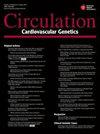Genetic Risk and Altering Lipids With Lifestyle Changes and Metformin: Is Fate Modifiable?
Q Medicine
引用次数: 1
Abstract
> It is not in the stars to hold our destiny but in ourselves > > —William Shakespeare The widespread availability and lower costs of genotyping and sequencing have resulted in the performance of a large number of genotype–phenotype association studies in cardiovascular medicine. The stringent requirements for correction for multiple testing and replication have particularly favored genotype–phenotype studies examining the association between genetic variation and quantitative traits that allows for greater statistical power. Multiple genome-wide association studies and a subsequent meta-analysis have identified >180 common and rare genetic variants associated with lipid traits.1,2 However, the effect size of these individual genetic variants is small, explaining only a small fraction of phenotypic variation prompting investigators to use genetic risk scores (GRS) that represent an aggregate of genetic risk to demonstrate clinical utility. Single-nucleotide polymorphisms (SNPs) and GRS have been used to predict cardiovascular disease such as coronary artery disease (CAD) and hypertension, surrogate markers of disease such as coronary calcium, cardiovascular outcomes such as myocardial infarction, and intermediate traits such as blood pressure and lipids.3 Article, see p 495 The Global Lipids Genetics Consortium has performed the largest genetic association study of lipid levels in 188 577 individuals from a total of 60 studies.1,2 There were 157 genetic loci that were identified, 95 were described previously and 62 were novel. The lipid level variance explained by the novel loci in this study ranged from 1.6% for high-density lipoprotein cholesterol (HDL-C) levels to 2.6% for total cholesterol levels. The total lipid variance explained by the previously described loci was 10% to 12%. The population studied was predominantly of European ancestry, and subjects on lipid-lowering therapy were excluded. The association of these genetic loci with lipid levels and a change in lipid levels with intervention in a prediabetic population …遗传风险和改变血脂与生活方式的改变和二甲双胍:命运可以改变吗?
掌握我们命运的不是星星,而是我们自己威廉·莎士比亚基因分型和测序的广泛可用性和较低的成本已经导致了心血管医学中大量基因型-表型关联研究的开展。多重测试和复制对校正的严格要求特别有利于基因型-表现型研究,研究遗传变异和数量性状之间的关系,允许更大的统计能力。多个全基因组关联研究和随后的荟萃分析已经确定了180个与脂质性状相关的常见和罕见遗传变异。然而,这些个体遗传变异的效应大小很小,只能解释一小部分表型变异,这促使研究人员使用遗传风险评分(GRS)来代表遗传风险的集合,以证明临床效用。单核苷酸多态性(snp)和GRS已被用于预测心血管疾病,如冠状动脉疾病(CAD)和高血压,疾病的替代标志物,如冠状动脉钙,心血管结局,如心肌梗死,以及中间性状,如血压和血脂。全球脂质遗传学协会进行了最大规模的脂质水平遗传关联研究,共对60项研究中的188577人进行了研究。1,2共鉴定出157个遗传位点,其中95个为已知遗传位点,62个为新遗传位点。本研究中新基因座解释的脂质水平变异范围从高密度脂蛋白胆固醇(HDL-C)水平的1.6%到总胆固醇水平的2.6%。由先前描述的位点解释的总脂质方差为10%至12%。研究人群主要是欧洲血统,排除了接受降脂治疗的受试者。这些基因位点与血脂水平的关系,以及干预后糖尿病前期人群血脂水平的变化……
本文章由计算机程序翻译,如有差异,请以英文原文为准。
求助全文
约1分钟内获得全文
求助全文
来源期刊

Circulation-Cardiovascular Genetics
CARDIAC & CARDIOVASCULAR SYSTEMS-GENETICS & HEREDITY
CiteScore
3.95
自引率
0.00%
发文量
0
期刊介绍:
Circulation: Genomic and Precision Medicine considers all types of original research articles, including studies conducted in human subjects, laboratory animals, in vitro, and in silico. Articles may include investigations of: clinical genetics as applied to the diagnosis and management of monogenic or oligogenic cardiovascular disorders; the molecular basis of complex cardiovascular disorders, including genome-wide association studies, exome and genome sequencing-based association studies, coding variant association studies, genetic linkage studies, epigenomics, transcriptomics, proteomics, metabolomics, and metagenomics; integration of electronic health record data or patient-generated data with any of the aforementioned approaches, including phenome-wide association studies, or with environmental or lifestyle factors; pharmacogenomics; regulation of gene expression; gene therapy and therapeutic genomic editing; systems biology approaches to the diagnosis and management of cardiovascular disorders; novel methods to perform any of the aforementioned studies; and novel applications of precision medicine. Above all, we seek studies with relevance to human cardiovascular biology and disease. Manuscripts are examined by the editorial staff and usually evaluated by expert reviewers assigned by the editors. Both clinical and basic articles will also be subject to statistical review, when appropriate. Provisional or final acceptance is based on originality, scientific content, and topical balance of the journal. Decisions are communicated by email, generally within six weeks. The editors will not discuss a decision about a manuscript over the phone. All rebuttals must be submitted in writing to the editorial office.
 求助内容:
求助内容: 应助结果提醒方式:
应助结果提醒方式:


